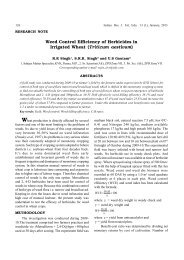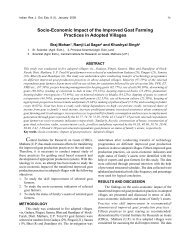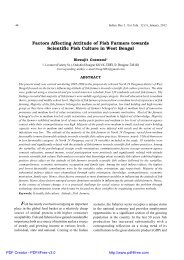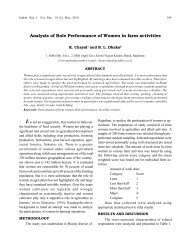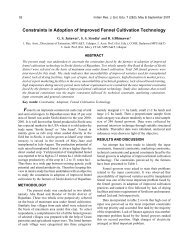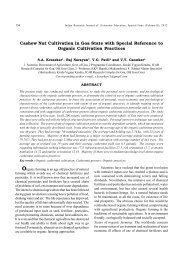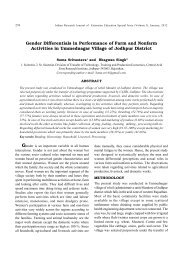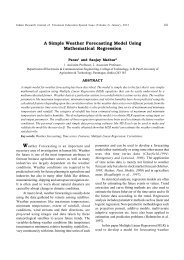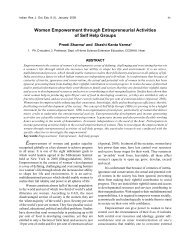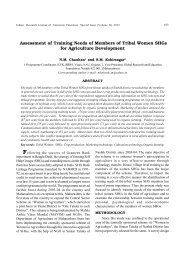Empowerment of Farmers through GALASA Programme - Seea.org.in
Empowerment of Farmers through GALASA Programme - Seea.org.in
Empowerment of Farmers through GALASA Programme - Seea.org.in
Create successful ePaper yourself
Turn your PDF publications into a flip-book with our unique Google optimized e-Paper software.
Indian Res. J. Ext. Edu. 12 (3), September, 2012 95the mean scores on the components like freeness towork with group members, participation <strong>in</strong> groupactivities, <strong>in</strong>volvement <strong>in</strong> decision mak<strong>in</strong>g, leadershipquality and group consensus to solve problem,develop<strong>in</strong>g <strong>in</strong>stitutional contact and l<strong>in</strong>kage withdevelop<strong>in</strong>g departments, group market<strong>in</strong>g skill anddevelop<strong>in</strong>g skill to solve conflict.Table 4. Economic empowerment <strong>of</strong> farmers <strong>in</strong> <strong>GALASA</strong><strong>Programme</strong> (N=60)Economic Mean Scores T testempowerment Before After valuecomponents Jo<strong>in</strong><strong>in</strong>g Jo<strong>in</strong><strong>in</strong>gIncreased <strong>in</strong>come due 2.3 3.3 1.8342to yield obta<strong>in</strong><strong>in</strong>gSav<strong>in</strong>g money 1.5 2.4 4.3848**Investments 1.2 1.7 6.5988**Avail<strong>in</strong>g agriculture loans 1.2 2.3 2.0157*F<strong>in</strong>ancial management skill 2.4 3.0 1.1696Extent <strong>of</strong> dependency on 1.0 1.0 NAmoney lendersAvail<strong>in</strong>g the facilities <strong>of</strong> KCCS 1.4 1.8 0.0030Avail<strong>in</strong>g personal <strong>in</strong>surance 1.5 1.8 0.0002Avail<strong>in</strong>g family <strong>in</strong>surance 1.0 1.0 NAAvail<strong>in</strong>g crop <strong>in</strong>surance 1.1 2.7 3.7410**Purchase <strong>of</strong> <strong>in</strong>puts <strong>of</strong> farm<strong>in</strong>g 1.7 3.5 2.7519**Total Mean Score 16.3 24.5Overall mean score 1.48 2.2t value (1% significance) = 2.661Economic empowerment: The economic empowerment<strong>of</strong> the farmer members was studied based on theselected parameters like <strong>in</strong>come, sav<strong>in</strong>gs habit,<strong>in</strong>vestments, f<strong>in</strong>ancial management skill, extent <strong>of</strong>dependency on money lenders, purchas<strong>in</strong>g <strong>of</strong> <strong>in</strong>put <strong>of</strong>farm<strong>in</strong>g etc. and given <strong>in</strong> Table 4.It is seen from the Table 4 <strong>in</strong>come <strong>of</strong> therespondents have been <strong>in</strong>creased, which might due tothe <strong>in</strong>crease <strong>in</strong> the yield obta<strong>in</strong>ed. Regard<strong>in</strong>g thepurchase <strong>of</strong> <strong>in</strong>puts for farm<strong>in</strong>g, respondents have ga<strong>in</strong>ed<strong>in</strong>creased mean score (3.5) especially after jo<strong>in</strong><strong>in</strong>g tothe group, because <strong>of</strong> the reason that the required farm<strong>in</strong>puts were provided by the Krishi bhavan <strong>through</strong>padasekhara samithies at a subsidized cost. With respectto avail<strong>in</strong>g <strong>of</strong> agricultural loans, farmers have beenempowered considerably (mean score 1.2 to 2.3), dueto reason that, PACS are provid<strong>in</strong>g <strong>in</strong>terest free loansto the <strong>GALASA</strong> members. The sav<strong>in</strong>gs <strong>of</strong> the membershave slightly <strong>in</strong>creased (2.4) <strong>in</strong>spite <strong>of</strong> poor return fromfarm<strong>in</strong>g. Increased mean score (2.7) was seen <strong>in</strong> thecase <strong>of</strong> crop <strong>in</strong>surance, due to reason that farmers haveavailed this facility be<strong>in</strong>g the member <strong>of</strong> the <strong>GALASA</strong>programme.The T-test computed also support the mean scoreobta<strong>in</strong>ed and shown significant difference <strong>in</strong> sav<strong>in</strong>g <strong>of</strong>money, <strong>in</strong>vestments, avail<strong>in</strong>g crop <strong>in</strong>surance andpurchas<strong>in</strong>g <strong>in</strong>puts.Table 5. Political empowerment <strong>of</strong> farmers <strong>in</strong> <strong>GALASA</strong><strong>Programme</strong> (N=60)Political Mean Scores T testempowerment Before After valuecomponents Jo<strong>in</strong><strong>in</strong>g Jo<strong>in</strong><strong>in</strong>gMembership <strong>in</strong> the social 1.7 1.8 0.0896<strong>org</strong>anizationsPosition <strong>in</strong> the political parties 1.3 1.4 1.0000Freedom <strong>of</strong> express<strong>in</strong>g 1.4 1.5 0.0327ideas <strong>in</strong> politicsConflict management 1.7 2.1 9.3474**Total mean score 6.1 6.9Overall mean score 1.5 1.7t value (1% significance) = 2.6617Political <strong>Empowerment</strong>: The political empowermentstudied with variables like membership <strong>in</strong> social<strong>org</strong>anization, position assumed <strong>in</strong> the political party,freedom <strong>of</strong> express<strong>in</strong>g ideas <strong>in</strong> politics and conflictmanagement and shown <strong>in</strong> Table 5.Table 5 reveals that the mean scores obta<strong>in</strong>ed bythe respondents <strong>in</strong> political empowerment components,before and after the <strong>GALASA</strong> programme seems tomore or less same. A few respondents were heldmembership <strong>in</strong> political parties. With respect to conflictmanagement, the average score obta<strong>in</strong>ed by therespondents was <strong>in</strong>creased by 0.4. Rest <strong>of</strong> othervariables, such as membership <strong>in</strong> social <strong>org</strong>anization,position <strong>in</strong> the political parties and freedom <strong>of</strong> express<strong>in</strong>gideas <strong>in</strong> politics, a slight improvement has been recorded.The T-test showed a significant difference <strong>in</strong> themean score obta<strong>in</strong>ed on Conflict management. The<strong>GALASA</strong> programme has provides greater scope onconflict management and hence it showed a significancechange on this dimension.Creativity empowerment : The subcomponents suchas generation <strong>of</strong> new ideas, orientation towards crisismanagement were studied to analyze the creativityempowerment component and presented <strong>in</strong> Table 6.Table 6 reveals that the mean scores obta<strong>in</strong>ed bythe respondents have not been changed considerably
96 Indian Res. J. Ext. Edu. 12 (3), September, 2012even after jo<strong>in</strong><strong>in</strong>g the <strong>GALASA</strong> programme.Withrespect to orientation towards crisis management, theaverage score was <strong>in</strong>creased from 2.1 to 2.8. Thechange <strong>in</strong> the mean score was ma<strong>in</strong>ly because <strong>of</strong> thenature <strong>of</strong> paddy cultivation, and subject to prone variousk<strong>in</strong>ds <strong>of</strong> risk. The T-test did not shown significantdifference <strong>in</strong> the mean scores on any <strong>of</strong> theempowerment variables under this dimension.Table 6. Creativity empowerment <strong>of</strong> farmers <strong>in</strong> <strong>GALASA</strong><strong>Programme</strong> ( N=60)S. Mean Scores T testNo. <strong>Empowerment</strong> variables Before After valueJo<strong>in</strong><strong>in</strong>g Jo<strong>in</strong><strong>in</strong>g1 Generation <strong>of</strong> novel ideas 1.6 1.7 0.01832 Orientation towards crisis 2.1 2.8 1.8151managementTotal mean score 3.7 4.5Overall mean score 1.9 2.3t value (1% significance) = 2.6617<strong>Empowerment</strong> Dynamics Index (EDI): <strong>Empowerment</strong>Dynamics Index were computed by <strong>in</strong>clusive <strong>of</strong> majorcomponents such as Knowledge <strong>Empowerment</strong>,Psychological <strong>Empowerment</strong>, Social <strong>Empowerment</strong>,Economic <strong>Empowerment</strong>, Political <strong>Empowerment</strong> andCreativity <strong>Empowerment</strong> and given <strong>in</strong> Table 7.It is evident from the Table 7 there was only 18per cent <strong>in</strong>crease <strong>in</strong> the empowerment dynamics <strong>in</strong>dex.This might be due to cumulative effect <strong>of</strong> empowerment<strong>in</strong> all components <strong>of</strong> empowerment. The <strong>in</strong>crease <strong>in</strong>EDI was reported for the psychological empowermentcomponent (30 per cent) followed by knowledgeempowerment component (18%), social empowermentcomponent (17%), and economic empowermentcomponent (15%), creativity empowerment component(8%) and political empowerment component (4%).Hence it is concluded that relatively considerableenhancement has noticed <strong>in</strong> all the dimensions <strong>of</strong>empowerment studied.Table 7. <strong>Empowerment</strong> Dynamics Index <strong>of</strong> farmers <strong>in</strong> the<strong>GALASA</strong> <strong>Programme</strong> (N=60)IndexDimensions <strong>of</strong> empowerment Before AfterJo<strong>in</strong><strong>in</strong>g Jo<strong>in</strong><strong>in</strong>gKnowledge <strong>Empowerment</strong> Index (KEI) 0.45 0.63Psychological <strong>Empowerment</strong> 0.41 0.71Index (PsyEI)Social <strong>Empowerment</strong> Index (SEI) 0.49 0.66Economic <strong>Empowerment</strong> Index (EEI) 0.30 0.45Political <strong>Empowerment</strong> Index (PEI) 0.31 0.35Creativity <strong>Empowerment</strong> Index (CEI) 0.37 0.45<strong>Empowerment</strong> Dynamics Index (EDI) 0.24 0.42CONCLUSIONTherefore it may possible to conclude that<strong>GALASA</strong> programme has provides immense scope forthe empowerment <strong>of</strong> farmers <strong>in</strong> all the dimensions andthereby assures susta<strong>in</strong>able rice production <strong>in</strong> the stateand ensur<strong>in</strong>g food security. More <strong>of</strong> team build<strong>in</strong>g andleadership management programme could be designedto suit for the farmers <strong>in</strong>terest group/commodity <strong>in</strong>terestgroup/self help group to nurture the empowerment.Exclusive tra<strong>in</strong><strong>in</strong>g module <strong>in</strong>corporat<strong>in</strong>g s<strong>of</strong>t skills onthe light <strong>of</strong> empowerment dimensions <strong>of</strong> farmers couldbe developed to meet the challenges <strong>of</strong> farm<strong>in</strong>g.Paper received on : June 21, 2011Accepted on : September 11, 2011REFERENCESAshokhan, M. (2006). A study on <strong>Empowerment</strong> <strong>of</strong> SHG operated <strong>in</strong> selected district <strong>of</strong> TamilNadu –An empirical study, Ph.Dthesis (unpub.), Dept <strong>of</strong> AE&RS, TNAU, Coimbatore.Bradley, L.; Kirkman, Kev<strong>in</strong>; B. Lowe and Diane. P. Young (1999). High-performance work <strong>org</strong>anizations, def<strong>in</strong>ition, practicesand an annotated bibiliography, Centre for creative Leadership, North Carol<strong>in</strong>a.Karpagam, C. (2009). Social dynamics <strong>of</strong> farmers <strong>in</strong> drip irrigation system <strong>of</strong> selected crops-An empirical study. Ph.D thesis(unpub.), Dept <strong>of</strong> AE&RS, TNAU, Coimbatore.




